Furnace Firebox Texas City Texas
Furnace Firebox Texas City Texas
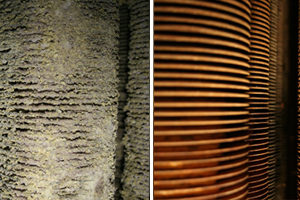
Furnace Firebox Texas City Texas
Oil cooler cleaning chemicals Texas City Texas
In industryFurnace firebox Texas City Texas
Heat exchangers are widely used in industry both for cooling and heating large-scale industrial processes. The type and size of heat exchanger used can be tailored to suit a process depending on the type of fluid, its phase, temperature, density, viscosity, pressures, chemical composition and various other thermodynamic properties.
In many industrial processes there is a waste of energy or a heat stream that is being exhausted, heat exchangers can be used to recover this heat and put it to use by heating a different stream in the process. This practice saves a lot of money in the industry, as the heat supplied to other streams from the heat exchangers would otherwise come from an external source that is more expensive and more harmful to the environment.
A simple heat exchange might be thought of as two straight pipes with fluid flow, which are thermally connected. Let the pipes be of equal length L, carrying fluids with heat capacity (energy per unit mass per unit change in temperature) and let the mass flow rate of the fluids through the pipes, both in the same direction, be (mass per unit time), where the subscript applies to pipe 1 or pipe 2.Furnace firebox Texas City Texas
Temperature profiles for the pipes are and where x is the distance along the pipe. Assume a steady state, so that the temperature profiles are not functions of time. Assume also that the only transfer of heat from a small volume of fluid in one pipe is to the fluid element in the other pipe at the same position, i.e., there is no transfer of heat along a pipe due to temperature differences in that pipe. By Newton’s law of cooling the rate of change in energy of a small volume of fluid is proportional to the difference in temperatures between it and the corresponding element in the other pipe:
( this is for parallel flow in the same direction and opposite temperature gradients, but for counter-flow heat exchange countercurrent exchange the sign is Furnace firebox Texas City Texas opposite in the second equation in front of ) Furnace firebox Texas City Texas
, where the thermal energy per unit length and γ is the thermal connection constant per unit length between the two pipes. This change in internal energy results in a change in the temperature of the fluid element. The time rate of change for the fluid element being carried along by the flow is: Furnace firebox Texas City Texas
where is the “thermal mass flow rate”. The differential equations governing the heat exchanger may now be written as: Furnace firebox Texas City Texas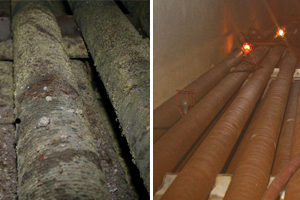
Note that, since the system is in a steady state, there are no partial derivatives of temperature with respect to time, and since there is no heat transfer along the pipe, there are no second derivatives in x as is found in the heat equation. These two coupled first-order differential equations may be solved to yield:
where , ,
(this is for parallel-flow, but for counter-flow the sign in front of is negative, so that if , for the same “thermal mass flow rate” in both opposite directions, the gradient of temperature is constant and the temperatures linear in position x with a constant difference along the exchanger, explaining why the countercurrent design countercurrent exchange is the most efficient )
and A and B are two as yet undetermined constants of integration. Let and be the temperatures at x=0 and let and be the temperatures at the end of the pipe at x=L. Define the average temperatures in each pipe as:
Using the solutions above, these temperatures are:
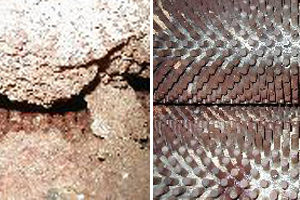 Choosing any two of the temperatures above eliminates the constants of integration, letting us find the other four temperatures. We find the total energy transferred by integrating the expressions for the time rate of change of internal energy per unit length:
Choosing any two of the temperatures above eliminates the constants of integration, letting us find the other four temperatures. We find the total energy transferred by integrating the expressions for the time rate of change of internal energy per unit length:
By the conservation of energy, the sum of the two energies is zero. TheFurnace firebox Texas City Texas quantity is known as the Log mean temperature difference, and is a measure of the effectiveness of the heat exchanger in transferring heat energy.Furnace firebox Texas City Texas
Construction.Furnace firebox Texas City Texas
The distance between the sheets in the spiral channels is maintained by using spacer studs that were welded prior to rolling. Once the main spiral pack has been rolled, alternate top and bottom edges are welded and each end closed by a gasketed flat or conical cover bolted to the body. This ensures no mixing of the two fluids occurs. Any leakage is from the periphery cover to the atmosphere, or to a passage that contains the same fluid. .Furnace firebox Texas City Texas
Self-cleaning [.Furnace firebox Texas City Texas
Spiral heat exchangers are often used in the heating of fluids that contain solids and thus tend to foul the inside of the heat exchanger. The low-pressure droplets the SHE handle fouling more easily. The SHE uses a “self-cleaning” mechanism, whereby fouled surfaces cause a localized increase in fluid velocity, thus increasing the drag (or fluid friction) on the fouled surface, thus helping to dislodge the blockage and keep the heat exchanger clean. “The internal walls that make up the heat transfer surface are often rather thick, which makes the SHE very robust, and able to last a long time in demanding environments.” They are also easily cleaned, opening out like an oven where any buildup of foulant can be removed by pressure washing. .Furnace firebox Texas City Texas
Self-cleaning water filters are used to keep the system clean and running without the need to shut down or replace cartridges and bags. .Furnace firebox Texas City Texas
Flow arrangements.Furnace firebox Texas City Texas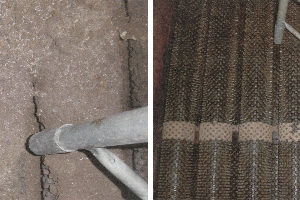
A comparison between the operations and effects of a concurrent and a countercurrent flow exchange system is depicted by the upper and lower diagrams respectively. In both it is assumed (and indicated) that red has a higher value (e.g. of temperature) than blue and that the property being transported in the channels therefore flows from red to blue. Note that channels are contiguous if the effective exchange is to occur (i.e. there can be no gap between the channels). .Furnace firebox Texas City Texas
There are three main types of flows in a spiral heat exchanger:
Counter-current Flow: Fluids flow in opposite directions. These are used for liquid-liquid, condensing and gas cooling applications. Units are usually mounted vertically when condensing vapor and mounted horizontally when handling high concentrations of solids. .Furnace firebox Texas City Texas
Spiral Flow/Cross Flow: One fluid is in spiral flow and the other in a cross flow. Spiral flow passages are welded at each side for this type of spiral heat exchanger. This type of flow is suitable for handling low-density gas, which passes through the cross flow, avoiding pressure loss. It can be used for liquid-liquid applications if one liquid has a considerably greater flow rate than the other. .Furnace firebox Texas City Texas
Distributed Vapour/Spiral flow: This design is that of a condenser, and is usually mounted vertically. It is designed to cater for the sub-cooling of both condensate and non-condensable. The coolant moves in a spiral and leaves via the top. Hot gases that enter leave as condensate via the bottom outlet. .Furnace firebox Texas City Texas
Applications.Furnace firebox Texas City Texas
The Spiral heat exchanger is good for applications such as pasteurization, digester heating, heat recovery, pre-heating (see: recuperator), and effluent cooling. For sludge treatment, SHEs are generally smaller than other types of heat exchangers. These are used to transfer the heat.
Selection.Furnace firebox Texas City Texas
Due to the many variables involved, selecting optimal heat exchangers is challenging. Hand calculations are possible, but many iterations are typically needed. As such, heat exchangers are most often selected via computer programs, either by system designers, who are typically engineers, or by equipment vendors. .Furnace firebox Texas City Texas
To select an appropriate heat exchanger, the system designers (or equipment vendors) would first consider the design limitations for each heat exchanger type. Though cost is often the primary criterion, several other selection criteria are important:
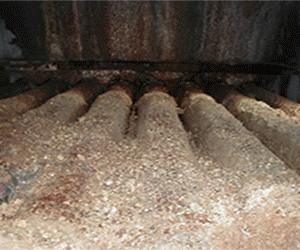 High/ low-pressure limits.Furnace firebox Texas City Texas
High/ low-pressure limits.Furnace firebox Texas City Texas
Thermal performance.Furnace firebox Texas City Texas
Temperature ranges.Furnace firebox Texas City Texas
Product mix (liquid/liquid, particulates or high-solids liquid).Furnace firebox Texas City Texas
Pressure drops across the exchanger
Fluid flow capacity
Cleanability, maintenance and repair.Furnace firebox Texas City Texas
Materials required for construction.Furnace firebox Texas City Texas
Ability and ease of future expansion.Furnace firebox Texas City Texas
Material selection, such as copper, aluminum, carbon steel, stainless steel, nickel alloys, ceramic, polymer, and titanium. .Furnace firebox Texas City Texas
Small-diameter coil technologies are becoming more popular in modern air conditioning and refrigeration systems because they have better rates of heat transfer than a conventionally sized condenser and evaporator coils with round copper tubes and aluminum or copper fin that have been the standard in the HVAC industry. Small diameter coils can withstand the higher pressures required by the new generation of environmentally friendlier refrigerants. Two small diameter coil technologies are currently available for air conditioning and refrigeration products: copper microgroove and brazed aluminum microchannel. .Furnace firebox Texas City Texas
Choosing the right heat exchanger (HX) requires some knowledge of the different heat exchanger types, as well as the environment where the unit must operate. Typically in the manufacturing industry, several different types of heat exchangers are used for just one processor system to derive the final product. For example, a kettle HX for pre-heating, a double pipe HX for the ‘carrier’ fluid and a plate and frame HX for final cooling. With sufficient knowledge of heat exchanger types and operating requirements, an appropriate selection can be made to optimize the process. Furnace firebox Texas City Texas. Furnace firebox Texas City Texas
Call Now: +1-856-678-4004
(Texas City, Texas) (Baton Rouge, Louisiana)
Houston •San Antonio •Dallas •Austin •Fort Worth •El Paso •Arlington •Corpus •Christi •Plano •Laredo •Lubbock •Irving •New Iberia •Luling •West Monroe •Ruston •Thibodaux •Natchitoches •Plaquemine •Abbeville •Leesville •Bastrop •Crowley •Donaldsonville •Franklin •Bogalusa •Minden •Eunic •Baton Rouge •Shreveport •Lafayette •Lake Charles •Opelousas •Morgan City •Monroe

